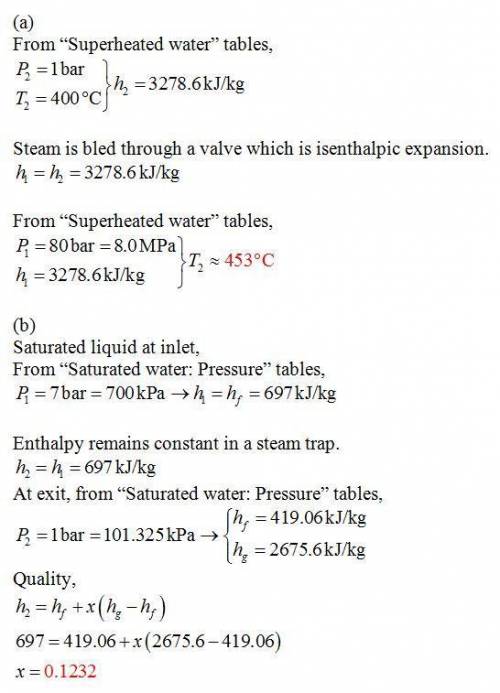
Engineering, 07.03.2020 04:04 gandalfhan
Valves on steam lines are commonly encountered and you should know how they work. For most valves, the change in velocity of the fluid flow is negligible. Apply this principle to solve the following problems. a. A pressure gauge on a high-pressure steam line reads 80 bar absolute, but temperature measurement is unavailable inside the pipe. A small quantity of steam is bled out through a valve to atmospheric pressure at 1 bar. A thermocouple placed in the bleed stream reads 400°C. What is the temperature inside the high-pressure duct? b. Steam traps are common process devices used on the lowest points of steam lines to remove condensate. By using a steam trap, a chemical process can be supplied with so-called dry steam, i. e., steam free of condensate. As condensate forms due to heat losses in the supply piping, the liquid runs downward to the trap. As liquid accumulates in the steam trap, it causes a float mechanism to move. The float mechanism is attached to a valve, and when the float reaches a control level, the valve opens to release ac

Answers: 1


Other questions on the subject: Engineering

Engineering, 04.07.2019 18:10, krystabrewer3
What are the two (02) benefits, which may result from a successful implementation of preventive maintenance (pm) program in an organization? (clo3)a)- lean manufacturing b)-overlapping responsibilities c)-the planner is not qualified d)-accurate contractor information e)-reduction in equipment redundancies f)-accurate stores information
Answers: 3


Engineering, 04.07.2019 19:10, netflixacc0107
What is the major difference between thermoplastics and thermosetting plastics from the polymerization structure point of view?
Answers: 2

Engineering, 04.07.2019 19:10, nbunny7208
What is the chief metrological difference between measuring with a microscope and with an electronic comparator? a. the microscope is limited to small workpieces. a. the microscope is limited to small workpieces. c. the comparator can only examine one point on the workpiece. d. the microscope carries its own standard.
Answers: 1
You know the right answer?
Valves on steam lines are commonly encountered and you should know how they work. For most valves, t...
Questions in other subjects:


English, 16.12.2020 01:40

Arts, 16.12.2020 01:40

Social Studies, 16.12.2020 01:40


World Languages, 16.12.2020 01:40



Biology, 16.12.2020 01:40





